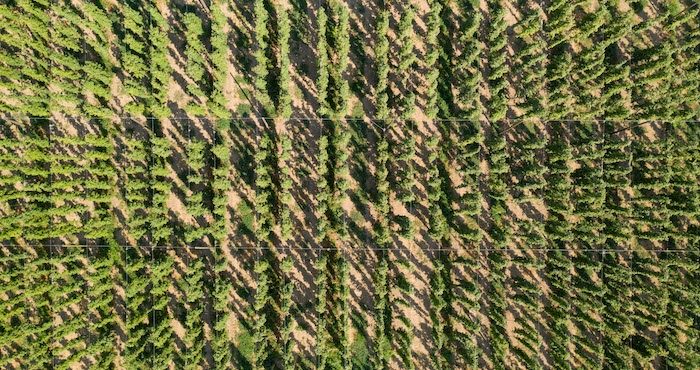The State of the Hops: Talking supply chain with Pete Mahony
We sat down with Pete Mahony, Vice President of Supply Chain Management at John I. Haas, to discuss his point of view on the state of the supply chain, and the year ahead.

 The USDA Hop Acreage Survey is due out in a couple of months—but the craft brewers we know are always eager to hear some news in advance of the report. So we thought it would be a great time to sit down with Pete Mahony, Vice President of Supply Chain Management here at John I. Haas, to discuss his point of view on the state of the supply chain, and the year ahead. Here are a few highlights of our conversation.
The USDA Hop Acreage Survey is due out in a couple of months—but the craft brewers we know are always eager to hear some news in advance of the report. So we thought it would be a great time to sit down with Pete Mahony, Vice President of Supply Chain Management here at John I. Haas, to discuss his point of view on the state of the supply chain, and the year ahead. Here are a few highlights of our conversation.
From an agronomical perspective, how do you see this year’s crop? There were concerns about water availability last year. How’s it looking for 2016?
Pete Mahony: The 2015 crop-growing season was very challenging due to a “one-two” punch of low water availability and record heat during the summer months. The water shortage was caused by an El Nino in the Pacific Ocean affecting the Washington growing region, which relies upon mountain snowpack to supplement its water reservoirs. Irrigation districts in the Yakima Valley were forced to implement water-rationing measures, with some of the junior districts receiving only 47% of normal water supplies.
Looking to the 2016 crop season, weather forecasters were predicting another El Nino to occur over the 2015-2016 winter; in fact a very strong one was predicted. This caused us quite some concern. Fortunately the effect of this year’s El Nino was much less severe than last winter and we were pleasantly surprised to see snowpack levels actually above normal levels. So maybe we dodged a bullet. We’re anticipating normal water availability for the 2016 crop season, which will help in achieving normal crop yields even if we experience a very warm summer.
Aroma varieties have been tight the last couple of years. What varieties remain tight and what do you see coming up for 2016 in general?
Pete: The supply of aroma varieties has been tight, despite the fact that recent acreage expansion in the U.S. has been almost entirely dedicated to aroma hops. The supply growth rate simply has not quite yet caught up with the dramatic growth of the domestic craft industry and its associated demand for aroma hops.
Cascade is now the most widely grown variety in the U.S. and supply constraints finally appear to be easing slightly. Demand for Centennial, on the other hand, has continued to keep supply very tight because this variety is prone to inconsistent yields from crop to crop. A handful of smaller niche varieties look to remain in tight supply such as Golding, Mt. Hood, and Sterling.
On the proprietary side, although varieties such as Citra®, Mosaic®, HBC 366 and Simcoe® have been the fastest-expanding varieties in recent years in terms of acreage, they continue to remain tight simply due to the continued strong demand from the craft segment. We expect at least 60% of the total 2016 crop acreage expansion to come from these four varieties collectively.
What steps is the hop industry taking to ensure supply, yet keep expansion at a responsible level?
Pete: A few years back, I don’t know if anyone could’ve anticipated the levels this craft bull market has reached. This phenomenal growth has placed quite a bit of pressure on the supply base, and on aroma hops in particular, for both traditional public varieties or new proprietary varieties. The hop industry has been in catch-up mode ever since this market took off, although some amazing progress has been made.
The low point in acreage was the 2011 crop, at about 29,800 acres. Over the next 4 years we’ve seen a total of 13,850 acres planted, an increase of nearly 50%! With virtually all expansion going into aroma varieties. However, we know this phenomenal growth rate is not sustainable over the long run—at least not at the current levels. It will be increasingly important for brewers to contract responsibly, to have good communication with their suppliers regarding forecasted volume needs, and to ensure forecasts are reasonable.
What specifically do you see in acreage increase in the U.S. for 2016?
Pete: We’re currently projecting an increase of 5,500–6,000 acres for 2016. This will again consist almost entirely of aroma hops for craft and would put the total PNW acreage in the range of 49–50,000 acres. Also, as noted earlier, it is likely 60–70% of the expansion will be planted with several of the popular proprietary aroma varieties.
Pricing’s a big issue, and I hear growers are fast approaching limitations on processing capacities. How does this affect the equation?
Pete: As the industry nears 50,000 acres in the PNW, the current acreage base is already pushing the capacity limits of grower’s infrastructure and has led to the expansion of several harvesting facilities over the past couple of years. Future acreage expansion will come at an increased cost to support these significant capital investments on the farms. These will be expensive acres so we need to be sure they are truly needed.
What specifically can brewers do to help keep a good balance between supply and demand—so hop suppliers can better manage hop inventories and expected usage?
Pete: It comes back to good communication with the hop suppliers, to have good forecasts, to purchase responsibly. Craft brewers have responded nicely to the need for future contracting, which greatly improved the ability of the industry to forecast demand and increase acreage accordingly. But we don’t want to get into a situation where we have an increasing share of the prior crop still sitting in supplier’s warehouses ten, twelve, fourteen months later. We need to minimize the luxury of over-buying and “giving back” what isn’t needed. The earlier brewers can communicate to their supplier that they are building long positions the better chance suppliers are to find other homes for this inventory. This could also assist in varietal acreage rebalancing the following season.
Reading some of the brewing blogs, how do you respond to those who believe hop suppliers are restricting the supply of some proprietary hop varieties to keep prices high?
Pete: These views simply are not supported by the facts. Five of the top 10 most widely grown varieties in the U.S. have come from private breeding programs. The varieties with the highest expansion rates in recent years are predominantly proprietary varieties to supply the craft segment, varieties such as Citra®, Mosaic®, Simcoe®, Amarillo®. The owners of these varieties want to increase the supply, but simply have not been able to catch up to the demand yet.
Also, remember that incredible care is taken to ensure that the rapid acreage increase is done with a great emphasis on quality and varietal purity. This places clear physical and agronomic limits on the expansion of these varieties. Another restriction on the industry’s ability to ramp up supply for the hot varieties is the fact that many aroma varieties, proprietary or public, fall within similar harvest windows. There certainly is no artificial restriction of supply as a means of keeping prices high. It’s just a very competitive market out there with tightness of acreage and capacity.
Craft brewers are in a pretty unique situation as far as needing flexibility in their hop requirements. What advice do you have for them in working with hop suppliers in meeting the continually changing demands in the beer market for established hop varieties and new releases?
Pete: Be informed, be agile, and keep open lines of communication with your hop supplier. The better the communication, the more opportunities there will be to adapt to changing brewer needs, whether it’s varietal changes, securing future needs, or rebalancing existing inventory positions. Also, it’s smart to keep on top of new varietals and product developments within the hop industry. It’s good to secure sample quantities, run brewing trials—and always be prepared to try something new.
